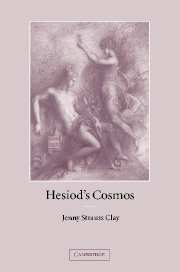Book contents
- Frontmatter
- Contents
- Preface
- Acknowledgments
- List of abbreviations
- Introduction
- 1 Orientations: the Theogony
- 2 Orientations: the Works and Days
- 3 Overtures
- 4 The origins and nature of mankind
- 5 The two Prometheuses
- 6 Perspectives on gods and men
- 7 Hybrids
- Conclusion: Hesiod and Calchas at Aulis
- Bibliography
- Indexes
2 - Orientations: the Works and Days
Published online by Cambridge University Press: 04 August 2010
- Frontmatter
- Contents
- Preface
- Acknowledgments
- List of abbreviations
- Introduction
- 1 Orientations: the Theogony
- 2 Orientations: the Works and Days
- 3 Overtures
- 4 The origins and nature of mankind
- 5 The two Prometheuses
- 6 Perspectives on gods and men
- 7 Hybrids
- Conclusion: Hesiod and Calchas at Aulis
- Bibliography
- Indexes
Summary
The preceding pages have offered a rough sketch of the Theogony's contents, highlighting those points where Hesiod makes significant organizational choices in the arrangement of his genealogies and in the placement of his digressions, choices that underline certain fundamental conceptions concerning the articulation of the cosmos. But the Theogony's armature remains essentially and necessarily tied to a genealogical framework as it traces the development and evolution of the divine cosmos from its origins to its present state. The organization of the Works and Days, however, possesses no such intrinsic necessity or obvious structure. As West remarks:
To anyone who expects an orderly and systematic progression of ideas, it is liable to appear a bewildering text. The same themes recur several times in different places, connections between neighbouring sections are often difficult to grasp, trains of thought are interrupted by seemingly irrelevant remarks, the didactic intention is here and there suspended in favour of pure description; and taken as a whole, the variety of contents is so great that it is hardly possible to describe the subject of the poem in a single phrase.
In the opinion of others, Hesiod's mode of composition involves a fairly fluid association of ideas whereby each section leads to the next, but the poem inevitably lacks an overall coherence or argument.
Any study of the poem must first confront a fundamental problem: the unity and coherence of the Works and Days as it has come down to us.
- Type
- Chapter
- Information
- Hesiod's Cosmos , pp. 31 - 48Publisher: Cambridge University PressPrint publication year: 2003

